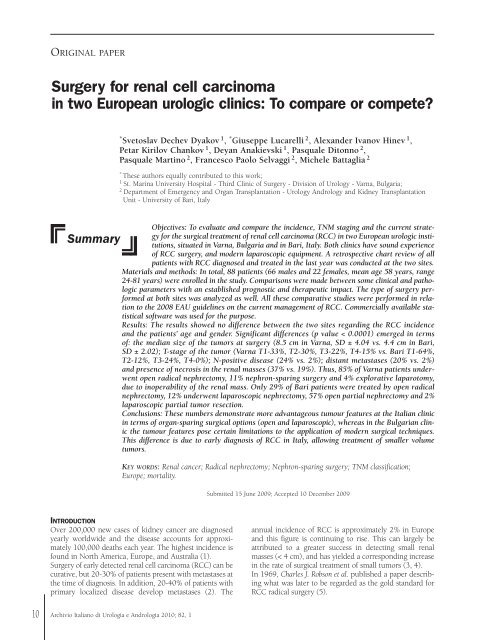Summary - Salute per tutti
Summary - Salute per tutti
Summary - Salute per tutti
- No tags were found...
Create successful ePaper yourself
Turn your PDF publications into a flip-book with our unique Google optimized e-Paper software.
ORIGINAL PAPERSurgery for renal cell carcinomain two European urologic clinics: To compare or compete?* Svetoslav Dechev Dyakov 1 , * Giuseppe Lucarelli 2 , Alexander Ivanov Hinev 1 ,Petar Kirilov Chankov 1 , Deyan Anakievski 1 , Pasquale Ditonno 2 ,Pasquale Martino 2 , Francesco Paolo Selvaggi 2 , Michele Battaglia 2* These authors equally contributed to this work;1 St. Marina University Hospital - Third Clinic of Surgery - Division of Urology - Varna, Bulgaria;2Department of Emergency and Organ Transplantation - Urology Andrology and Kidney TransplantationUnit - University of Bari, Italy<strong>Summary</strong>Objectives: To evaluate and compare the incidence, TNM staging and the current strategyfor the surgical treatment of renal cell carcinoma (RCC) in two European urologic institutions,situated in Varna, Bulgaria and in Bari, Italy. Both clinics have sound ex<strong>per</strong>ienceof RCC surgery, and modern laparoscopic equipment. A retrospective chart review of allpatients with RCC diagnosed and treated in the last year was conducted at the two sites.Materials and methods: In total, 88 patients (66 males and 22 females, mean age 58 years, range24-81 years) were enrolled in the study. Comparisons were made between some clinical and pathologicparameters with an established prognostic and therapeutic impact. The type of surgery <strong>per</strong>formedat both sites was analyzed as well. All these comparative studies were <strong>per</strong>formed in relationto the 2008 EAU guidelines on the current management of RCC. Commercially available statisticalsoftware was used for the purpose.Results: The results showed no difference between the two sites regarding the RCC incidenceand the patients’ age and gender. Significant differences (p value < 0.0001) emerged in termsof: the median size of the tumors at surgery (8.5 cm in Varna, SD ± 4.04 vs. 4.4 cm in Bari,SD ± 2.02); T-stage of the tumor (Varna T1-33%, T2-30%, T3-22%, T4-15% vs. Bari T1-64%,T2-12%, T3-24%, T4-0%); N-positive disease (24% vs. 2%); distant metastases (20% vs. 2%)and presence of necrosis in the renal masses (37% vs. 19%). Thus, 85% of Varna patients underwentopen radical nephrectomy, 11% nephron-sparing surgery and 4% explorative laparotomy,due to ino<strong>per</strong>ability of the renal mass. Only 29% of Bari patients were treated by open radicalnephrectomy, 12% underwent laparoscopic nephrectomy, 57% open partial nephrectomy and 2%laparoscopic partial tumor resection.Conclusions: These numbers demonstrate more advantageous tumour features at the Italian clinicin terms of organ-sparing surgical options (open and laparoscopic), whereas in the Bulgarian clinicthe tumour features pose certain limitations to the application of modern surgical techniques.This difference is due to early diagnosis of RCC in Italy, allowing treatment of smaller volumetumors.KEY WORDS: Renal cancer; Radical nephrectomy; Nephron-sparing surgery; TNM classification;Europe; mortality.Submitted 15 June 2009; Accepted 10 December 2009INTRODUCTIONOver 200,000 new cases of kidney cancer are diagnosedyearly worldwide and the disease accounts for approximately100,000 deaths each year. The highest incidence isfound in North America, Europe, and Australia (1).Surgery of early detected renal cell carcinoma (RCC) can becurative, but 20-30% of patients present with metastases atthe time of diagnosis. In addition, 20-40% of patients withprimary localized disease develop metastases (2). Theannual incidence of RCC is approximately 2% in Europeand this figure is continuing to rise. This can largely beattributed to a greater success in detecting small renalmasses (< 4 cm), and has yielded a corresponding increasein the rate of surgical treatment of small tumors (3, 4).In 1969, Charles J. Robson et al. published a pa<strong>per</strong> describingwhat was later to be regarded as the gold standard forRCC radical surgery (5).10Archivio Italiano di Urologia e Andrologia 2010; 82, 1
















